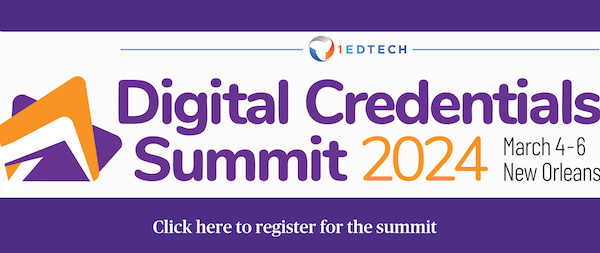Published on
Strategic and Operational Roadblocks to Broad Acceptance of Microcredentials

I had the pleasure of being on a team that designed microcredentials at a previous institution and published about our work. We informed early definitions of terms, creation of metadata standards and the development of a review process for new microcredentials at the institution. The challenges we experienced at that time are not dissimilar to those institutions face today.
There is still no agreement among higher education institutions and other entities developing microcredentials as to what constitutes a microcredential, with definitions varying by institution or entity. There are efforts to develop a shared taxonomy, but that effort has not yet been broadly embraced. Institutions launching microcredentials have had to develop their own vision and framework for utilizing microcredentials on their campus, author their own taxonomy, develop a review or governance process, identify the badging platform they will use and develop a process for awarding the badges. It has required documenting lessons learned and iterating on the original vision, as the number of microcredential offerings increase. Identifying manual processes that inhibit mircrocredential growth and that are taxing on staff are an essential part of that early work for institutions.
As a newcomer to the institution, this article was a good opportunity to learn and share more about the challenges senior administrator at Northeastern University faced. For this article, I interviewed Dr. Mike Jackson. Mike currently serves as the Vice Provost of Curriculum & Programs at Northeastern University. As part of his portfolio, Mike leads the modules and badging initiative for the university and chairs the committee overseeing inter-institutional educational agreements.
From the perspective of the provost’s office, what are the biggest strategic roadblocks for broad acceptance and development of microcredentials?
The development of a university strategy for microcredentials requires finding a balance between the vision of an academic plan, building a framework that provides a clear structure for product development and a staged approach for implementation that allows for framework revision in response to academic and non-academic departments’ needs. There isn’t an out-of-the-box approach to building a strategy because the opportunities and possibilities for microcredentials are wide and varied, and to be successful, a university should look to align that work to the institutional values and identity that all their programs reflect. The microcredential framework defines the parameters for building content and sets the relationship between microcredentials and traditional modules of content (courses, minors, programs, etc.). A central benefit of developing microcredentials is that it leverages an enormous amount of existing content, allowing for new content to be created without the same overhead of curriculum development; the framework should allow for innovation but also clearly differentiate between types of content (credit-bearing vs. non-credit, for example). Developing the framework is heavily dependent on the scope and scale of the microcredential strategy at the institutional level. A centralized approach with a focus on professional development and Continuing Education will present different challenges than a strategy intended for implementation across academic units that require both an established framework and autonomous product development for each college, department or unit.
When building the team tasked with developing the strategy and framework for microcredentialing, it’s important to have representation from the appropriate academic and non-academic departments, so the approach is not only pedagogically sound but also integrates the best practices from instructional design while ensures integration with the institution’s registration and records systems, marketing, recruitment and admissions. There is the risk of the working group becoming too large, but building out the strategy and framework without understanding the required resources and operations limitations will lead to building a program that is not sustainable or scalable.
Identifying the audiences for an institution’s microcredentials should be a central design principle of both the overall strategy and the framework, as those decisions require different levels of financial and operational commitment from the institution. Microcredentialing internal to the institution requires fewer dedicated resources, while development and implementation for B2B or B2C markets add the need for a more nuanced strategy that accounts for the each audience’s needs and the operational challenges of providing content to an external customer base, from registration and billing to marketing and enrollment.
It’s very easy to see all the possibilities for microcredentials and build products before you have thought through the logistics of delivering them. B2B and B2C markets require many dedicated resources for building partnerships and building a reputation in the marketplace, and early attempts are often met with disappointing results. There can also be a temptation to see potential value for modules and workshops that employers or individual learners don’t share. This is particularly true for higher education, which is built on providing fully formed degree and certificate programs that build upon one another.
Once a strategy is developed, the next challenge is messaging to departments, which includes a clear explanation of the institutional strategy and framework with the rationale behind it and providing appropriate pedagogical and technical training for content creation. Academic departments should develop content in alignment with the university strategy and framework, with the understanding that the framework will most likely change in the early stages of development. A staged approach to implementation allows departments and programs that are early adopters to chart a course for other departments to follow and iterate on. This approach will also provide an opportunity for the operations teams to work out the technical and systems issues that will inevitably arise without creating a logjam or negative learner experience. There is often excitement around the idea of microcredentials, but without guidance and support, it is easy for departments to either lose interest or develop content that does not accomplish the intended strategic goals.
Having a central resource for microcredentials that explains the strategy, describes its alignment with the academic plan and provides the framework with rationale will help maintain consistency in content development and mitigate confusion.
Based on the strategic challenges you described, what have you been doing at Northeastern to mitigate the roadblocks? What has worked well, and what have you had to change about your approach?
At Northeastern, we had the Executive Vice Provost of Curriculum & Programs put together a team of people who work in instructional design, digital transformation, academic technologies, student records, academic affairs and faculty with experience teaching online and developing digital learning pedagogy to develop a strategy and framework for the university that aligned with the academic plan. The group conducted market research on microcredentials in institutions of higher education and the private sector to better understand the landscape and to consider ways in which Northeastern could differentiate itself. This data helped inform the scale and scope of the strategy and the development of the framework for module creation.
This committee split into several working groups that consisted of representatives from each of the content areas listed above to work independently on taxonomy, audience profiles, operations and policy. The working groups convened together on a set cadence to provide updates and align the work into a single strategy and framework. Through this process, the committee identified technical and operational issues that would need to be addressed prior to launch and worked collaboratively to identify the nuances that the strategy would need to require, given the decision to offer microcredentials across a wide range of learners both internal and external to the university.
As part of the development process, a few pilot projects were developed to test the strategy and review the framework in practice. Through these pilots, the committee was able to revise the strategy to better suit learners’ needs and identify previously unconsidered roadblocks. Chief among them was recognizing the need to catalog the modules that would be eligible as a microcredential to facilitate record-keeping and cut back on any redundancy in our offerings.
In launching the strategy, it became clear that additional policy work was needed to accommodate the growing portfolio and ensure academic standards and quality were being met. To manage that work, a review and assessment committee was formed, and all new modules are now required to be vetted by that group before the module can be offered.
Both committees continue to work in their respective areas and work collaboratively to assess and revise the framework based upon lessons learned, new product ideas and market demand.
Expanding our offerings across the academic units continues to be a challenge, as many of the colleges are still developing their internal strategies for microcredentials. To help the colleges, the working group dedicated to the project is building additional support resources and developing a series of product lines that will help faculty envision how their microcredentials can be categorized and used to create pathways for supplemental learning, skill development, and student progress tracking through a degree program.
From the perspective of the provost’s office, what are the biggest operational roadblocks to development and broad acceptance of microcredentials? Based on the operational challenges you described, what have you been doing at Northeastern to mitigate the roadblocks? What has worked well, and what have you had to change about your approach?
The biggest operational roadblocks are choosing a platform to manage content, integrating with university systems and creating a process for new content review and tracking. These roadblocks can be further complicated if the university strategy includes offering microcredentials to external learner populations.
Choosing a content platform and integration with university systems are concerns that span several operational units on campus and require active communication and collaboration to solve. These operations challenges fall primarily on the registrar’s office as the unit responsible for student records, although they may also include enrollment management and billing, depending on the university strategy.
B2B and B2C learner populations created a significant hurdle, in that our course registration system is intended for degree-seeking students, not individuals looking to take a single course or workshop. With the first round of professional development workshops, learners were required to use the same registration system as enrolled students, which was not user-friendly and created back-end issues for the registrar’s office. Based upon those experiences, the university engaged with a vendor to provide a storefront experience for learners that allows them to select and pay for modules and workshops more easily. There are still issues with the registration process for modules that are a mix of enrolled students and learners from outside the university, but the overall learner experience for the learner has greatly improved.
Developing and managing a comprehensive learner record is another roadblock that the university is looking to overcome. Our strategy for microcredentials is rooted in developing pathways for lifelong learning. And to realize that goal, it is vital to have a record of learning that extends beyond the official transcript and collects all student learning opportunities. Overcoming this roadblock continues to be a work in progress.
As we face these challenges, there are moments of looking back at the strategy and framework with an eye to revision. But due to the work that went into developing our approach, those revisions have been minimal and focused on reconsidering the market for our microcredentials over reworking the framework. Technical and operational roadblocks are largely managed by keeping current with the industry and making decisions based on our strategy and its relationship with the university’s academic plan.
What advice would you give to other institutions consideringmicrocredentials?
The best advice that I can give to institutions considering offering microcredentials or looking to revise their current strategy is to spend the time identifying why they want to offer them, how a microcredentialing strategy ties into their academic plan and which audiences they are seeking to reach. By being clear on purpose and goals from the start, the work of building a strategy and framework becomes much easier and will help inform your decisions around policy, marketing, operations and technical needs. There are many different approaches and uses for microcredentials in higher education, and it is easy to get lured into seeing all the possibilities without fully understanding what it will require to achieve them. In my experience, this work is ongoing and involves a lot of trial and error. But through those experiences, the path forward for your institution becomes clearer.
Thank you, Dr. Mike Jackson, for sharing information about Northeastern University’s approach to offering microcredentials, which is consistent with best practices in the field. These best practices include:
- Creating an institution-specific centralized approach and strategy for microcredentials with a clear purpose and goals that encompasses unique opportunities and possibilities
- Engaging a diverse team in the microcredentials work for sustainability and scalability
- Ensuring all required technical systems are in place prior to launching microcredentials (e.g., registration, payment, learning management system, badging platform)
- Securing the institution’s financial and operational commitment to microcredentials, without which sustainability and scalability are impossible
- Conducting pilots to identify unexpected roadblocks and successes
- Developing and testing policies during the pilot phase and creating a process for an ongoing review of policy as microcredentials are scaled
- Being prepared for early disappointments and iterating for broader success.
- Considering the use of a comprehensive learner record to capture both credit and non-credit learning.
- Planning for ongoing review of the institution’s approach, strategy, policies, technologies, processes and learner experience for continuous improvement
I am thrilled to be at Northeastern University and look forward to contributing to the microcredentials the university offers in the near future.

Author Perspective: Administrator



